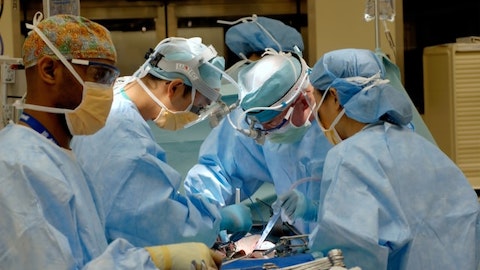Compugen Ltd. (NASDAQ:CGEN) Q4 2023 Earnings Call Transcript March 5, 2024
Compugen Ltd. beats earnings expectations. Reported EPS is $0.11, expectations were $0.1. CGEN isn’t one of the 30 most popular stocks among hedge funds at the end of the third quarter (see the details here).
Operator: Ladies and gentlemen, thank you for joining us today. Welcome to Compugen’s Fourth Quarter and Full Year 2023 Results Conference Call. At this time, all participants are in a listen-only mode. An audio webcast of this call is available in the Investors section of Compugen’s website www.cgen.com. As a reminder, today’s call is being recorded. I would now like to introduce Yvonne Naughton, Head of Investor Relations and Corporate Communication. Yvonne, please go ahead.
Yvonne Naughton: Thank you, operator, and thank you all for joining us on the call today. Joining me from Compugen for the prepared remarks are Dr. Anat Cohen-Dayag, President and Chief Executive Officer; and Alberto Sessa, Chief Financial Officer; Dr. Michelle Mahler, Chief Medical Officer; and Dr. Eran Ophir, Chief Scientific Officer, will join us for the Q&A. Before we begin, we would like to remind you that during this call, the company may make projections or forward-looking statements regarding future events, business outlook, development efforts and the potential outcome, the company’s discovery platform, anticipated progress and plans, results and time lines for our programs, financial and accounting related matters as well as statements regarding our cash position.
We wish to caution you that such statements reflect only the company’s current beliefs, expectations and assumptions, but actual results, performance or achievements of the company may differ materially. These statements are subject to known and unknown risks and uncertainties, and we refer you to the SEC filings for more details on these risks, including in the company’s most recent annual report on Form 20-F. The company undertakes no obligation to update projections and forward-looking statements in the future. And with that, I’ll turn the call over to Anat.
Anat Cohen-Dayag: Thank you, Yvonne, and thanks to everyone for joining our call today. Before we discuss the full year and fourth quarter highlights, I want to start by welcoming the new addition to our management team, Michelle Mahler, who took over the role of Chief Medical Officer on March 1st, 2024. I’m really excited to welcome Michelle, an oncologist by training, with extensive experience in leading clinical development in both biotech and pharma companies in and outside of the US. Michelle is an excellent fit for Compugen and will be a great partner to me and a collaborator to the whole team as we work together on executing our programs to accelerate value creation. I would like to take this opportunity to thank Henry for his major contributions and commitment to Compugen and his leadership.
Henry has been instrumental for the successful transition of Compugen from a preclinical to clinical stage company and creating the growth opportunities in front of us. Moving now to the highlights of 2023. Our successes in 2023 and in the last quarter, in particular, position us well as we advance into 2024 and are expected to play an important role in the exciting future and vision for Compugen. Firstly, at the end of the year, we executed a preclinical licensing deal with Gilead for a total deal value of up to $848 million including a $60 million upfront payment and $30 million near-term milestone payment and with additional single-digit to low double-digit royalties on future net sales. Delighted by Gilead of COM503, for which we are expected to lead Phase I development further validates our computational discovery, research and development capabilities.
It is also a testament to the differentiation of our antibody program targeting the IL-18 binding protein. The deal process was competitive, which reflects the significant interest in the IL-18 space and highlights the potential of our COM503’s differentiated antibody approach. As a reminder, COM503, a potential first-in-class anti-IL-18 binding protein antibody represents a novel way to harness IL-18 pathway biology for the treatment of cancer by using an antibody against IL-18 binding protein and therefore potentially avoiding the challenges presented by [Technical Difficulty]. Secondly, focusing on execution and advancing the development of our clinical stage assets, we initiated two proof-of-concept clinical studies with our differentiated COM701 combination in platinum-resistant ovarian cancer and metastatic microsatellite stable colorectal cancer.
We completed enrollment in the ongoing MSS-CRC study and we significantly ramped up the enrollment of our ongoing PROC study with enrollment of at least 20 patients expected by the end of the first quarter of 2024. In addition, we presented new data at scientific conferences throughout 2023, including preliminary evidence supporting the association between the biomarker, PVRL2 and clinical benefit intended to guide the next step in our development path for COM701 combination. Thirdly, in the fourth quarter of 2023, our partner, AstraZeneca advanced rilvegostomig their PD-1/TIGIT bispecific, the TIGIT component of which is derived from Compugen’s COM902 into Phase III development in biliary tract cancer. Dosing of the first patient in this Phase III trial entitled us to a milestone payment and brings Compugen one step closer to a potentially marketed drug.
AstraZeneca’s broad clinical investigation of this asset across multiple indications and across various lines of treatment and combinations increases on probability of realizing future milestone payments and royalties. Finally, the cash received from our licensing deal with Gilead, a milestone met by AstraZeneca in 2023 allow us to move into 2024 with a solid balance sheet. The additional cash we received and the cash we expect to receive upon IND clearance of COM503 is expected to extend our cash runway from the end of 2024 into 2027 and potentially accelerate value creation by enabling us to invest in enhancing our discovery capabilities and advancing our diversified portfolio, including our differentiated COM701, COM902, IO combination strategy, the Phase I development of COM503 and our early-stage innovative pipeline.
This is an expecting time for Compugen. This is a good segue for me to move to what to expect from us in 2024. 2024 is planned to be a catalyst-rich year for us with multiple data readouts and update expected from our diversified portfolio. In 2024, we plan to share data from our ongoing proof-of-concept study, NSCLC and platinum-resistant ovarian cancer. These are particularly challenging indications to treat and have historically failed to respond to neurotherapy. While we believe that these indications represent a very high bar, we have previously presented encouraging clinical data, supported by immune activation, suggesting that the unique biology of PVRIG enables anti-PD-1 activity in this challenging indications. The goal of these studies is to further substantiate our clinical findings including our initial biomarker results to potentially enable us to move forward with the biomarker and reach development strategy.
Regarding NSCLC, in the first cohort of 22 patients treated with COM701 in combination with nivolumab, we showed an encouraging overall response rate of 12% and stable diseases in patients with liver metastases, a patient population, which historically has not responded to other drugs. For the ongoing proof-of-concept study, our objective is to understand if there could be an additional benefit of adding an anti-TIGIT to the dual combination and further evaluate the combination in the liver metastasis patient population which represents approximately 70% of the patient population in the evaluated line of treatment. The ongoing study fully recruited in 2023 at a speed which we believe reflects the significant unmet need. Data presentation from this ongoing study is planned for the first half of 2024 with the aim to be presented at a medical conference.
You can expect to see baseline characteristics, including safety, overall response rate, disease control rate, duration of response and translational data. In patients with platinum-resistant ovarian cancer, based on the data from the first cohort of 20 patients treated with triple combination, there was a lot of excitement from investigators reporting durable shrinking or stabilization of tumors in some of their patients who had previously progressed on all available treatment options. We believe the totality of the data reported in these patients is encouraging compared to the current standard of care. We presented a 20% overall response rate with patients responding for over 16 months, which is favorable considering median duration of response for single-agent chemotherapy is around three to four months and in ADC is around 6.9 months.

Responses were also achieved in the hard-to-treat high-grade serous adenocarcinoma patients, along with a favorable safety profile. For the ongoing study in platinum-resistant ovarian cancer, we are delighted to report that our investigators are active on recruitment and we expect to complete recruitment of at least 20 patients this quarter and plan to present in the fourth quarter of 2024. Again, our preference will be to present at a medical conference. For this ongoing study, you can expect to see baseline characteristics and data for at least 20 patients, including safety, overall response rate, disease control rate, duration of responses and preliminary biomarker data. Moving now to COM503. Rapid execution on both COM503 IND clearance and Phase I development is a priority for us and were intensified by Gilead on this priority.
We greatly value the partnership with Gilead. And together, we’re well advanced on the Phase I trial design and feel confident that we can initiate Phase I shortly after we gain IND clearance. We are on track for IND submission in the second half of 2024 with subsequent initiation of the Phase I study following IND clearance. Finally, in the second half of 2024, AstraZeneca expects data from their Phase I/II ARTEMIDE-01 trial in non-small cell lung cancer in frontline setting and their Phase II GEMINI trial in hepatobiliary cancer. Before handing over to Alberto to go through our financials, I want to emphasize that we will continue to be financially disciplined, while benefiting from our solid cash position to enhance and advance our company.
We’re strategic with how we deploy our resources, and this will include two main priorities. One, advancing our clinical stage programs, COM701 and COM902 combinations and COM503 upon initiation of its clinical study; and two, investing in Compugen’s core competitive advantage, the integration of our computational discovery platform with innovative research and drug development capabilities. In terms of COM701 combination, advancing our ongoing studies will be data and biology driven. In PROC, we believe data showing durable responses and additional biomarker correlations are expected to allow us to move ahead employing a predictive biomarker enrichment strategy. As a result of the evolving platinum-resistant ovarian cancer treatment landscape, we see the opportunity for COM701 combination to be used in the treatment option in two patient populations, those progressing on ADCs and those ineligible for ADC.
In MSS-CRC, the bar is very high due to the many failures and the nonresponsive nature of the liver metastasis patient population. We believe the data showing an overall survival advantage over standard of care would be encouraging. Our study in MSS-CRC is still ongoing as some of the patients enrolled only in September ’23. And based on data from the overall and the liver metastasis patient population, we will determine the next steps. Based on the encouraging safety and efficacy data generated to date, with our COM701 combination across indications, we believe there is an opportunity to collaborate with potential partners to bring COM701 combination to patients across a broad range of indications, generating a potentially large opportunity.
For the second main priority, we will continue to invest in the engine powering our core competitive advantage. We’re skilled and highly experienced in integrating cutting-edge computational capabilities with groundbreaking immuno-oncology research and drug development expertise to discover novel drug targets. Investing to enhance our computational discovery platform from computer prediction to early-stage programs, we believe, will enable us to progress the generation of novel drug candidates, the next COM503. And finally, our focus remains on non-diluted funding for which we have demonstrated in 2023, we can successfully execute on. With that, I turn the call over to Alberto.
Alberto Sessa: Thank you, Anat. I’m delighted to say that we advanced into 2024 with a solid balance sheet. This is a result of competent accomplishments on the collaboration front in 2023, securing non-dilutive funding, which was always our priority. With cash at end to date and the milestone payment we expect to receive upon IND clearance of COM503, we expect to extend our cash runway to support our operating plans into 2027. Going into the details, I will start with our cash balance. As of December 31st, 2023, we had approximately $51.1 million in cash, cash equivalents, restricted cash and cash investments compared with approximately $83.7 million as of December 31st, 2022. The cash balance at the end of 2023 does not include the receipt of $60 million upfront payment from Gilead for our COM503 preclinical license and $10 million milestone payments from AstraZeneca on dosing the first patient in the Phase III trial.
In addition, in 2024, we expect to receive from Gilead, an additional $30 million milestone payment upon COM503 IND clearance. I would like to remind you that all payments from Gilead are subject to 15% withholding tax. The company has no debt. As Anat mentioned, we understand the importance of our cash balance and we are financially disciplined. Based on our current plans, we expect that our current cash, together with the milestone payment payable upon COM503 IND clearance will be sufficient to fund our operating plans into 2027. The cash run rate reflects the planned development of our clinical assets and continued investments in our early innovative pipeline. On the revenues front, we reported approximately $33.5 million in revenues for the fourth quarter of 2023 and for the year ended December 31st, 2023, compared to $7.5 million in revenues for each of the comparable periods in 2022.
The revenues for the year ended December 31st, 2023, include the portion of the upfront payment from the license agreement with Gilead allocated to the license and the clinical milestones from the license agreement with AstraZeneca in the amount of $10 million. Now moving to expenses. R&D expenses for the fourth quarter of 2023 and for the year ended December 31st, 2023, were $10.9 million and $34.5 million, respectively, compared with $7.3 million and $30.6 million for the comparable period in 2022. The increase in 2023 is mainly due to lower amortization of the deferred participation in R&D expenses following the termination of the agreement with BMS, offset by decrease in headcount related expenses. Research and development expenses as of the percentage of the total operating expenses were approximately 78% in 2023 compared to 73% in 2022.
Our G&A expenses for the fourth quarter of 2023 and for the year ended December 31st, 2023, were $2.5 million and $9.7 million, respectively, compared with approximately $2.5 million and approximately $10.3 million for the comparable period in 2022. Finally, on net loss. For the fourth quarter of 2023, we report a net profit of $9.7 million or $0.11 per basic and diluted share compared to a net loss of $3.1 million or $0.04 per basic and diluted share in the comparable period of 2022. Net loss for the year ended December 31st, 2023, was $18.8 million or $0.21 per basic and diluted share compared with a net loss of $33.7 million or $0.39 per basic and diluted share in the comparable period of 2022. With that I will hand back to Anat to summarize.
Anat Cohen-Dayag: Thanks, Alberto. To summarize, 2023 was a very successful year for Compugen, both on the execution front and the validation of our computation discovery and development capabilities, including the exciting preclinical license deal with Gilead for our IL-18 BP immunology program, the initiation of two proof-of-concept studies in presentation of preliminary predictive biomarker data with our unique and innovative triple IO combination and progress by our partner at AstraZeneca initiating a Phase III trial with rilvegostomig. Our accomplishments in 2023 position us well for catalyst to reach 2024 and with an extended cash runway expected into 2027, which we believe will support the development of our clinical assets and novel early-stage pipeline.
Partnering remains an important part of our strategy and we’ll continue to focus on collaborating to extend the reach of our potentially first-in-class medicines to cancer patients and to accelerate value creation. I would like to thank all our colleagues here as confidence for their passion and commitment to our success in 2023 and their dedication and readiness to drive for success in 2024. With that, I will turn the call over to questions. Operator?
Operator: Thank you. Ladies and gentlemen, at this time, we will begin the question-and-answer session. [Operator Instructions] The first question is from Asthika Goonewardene of Truist. Please go ahead.
See also 17 Countries with Highest CD Rates in 2024 and 15 Cities with the Most CCTV Cameras in the World.
Q&A Session
Follow Compugen Ltd (NASDAQ:CGEN)
Follow Compugen Ltd (NASDAQ:CGEN)
Asthika Goonewardene: Hey, guys. Good morning and thanks for taking my questions and congrats on all the progress that have been made. Totally agree, looking forward to seeing how the catalyst play out this year, this will be a very interesting year for the company. Anat, I just wanted to check in on the colorectal cancer data, which I’m sure I think everyone on the call is probably assuming that we could see that around ASCO. Perhaps I missed this, will you have biomarker data in that presentation? I know you said you have some translational data, but just want to specifically clarify if there will be biomarker data that you can tie to response?
Anat Cohen-Dayag: So it’s a very good question. And we did say that will relate to translational. I want to remind you that with the prior cohort of 22 patients where we disclosed the data already in ’23, we did not share biomarker correlations. We did not see biomarker correlations in CRC with the prior cohort. If we’ll have anything to report in the — with the next cohort, we’ll do that. But I think that it’s fair to say, to mention that up until now, we did not see in the prior cohort biomarker correlations. Eran, is there anything that you want to add on this front?
Eran Ophir: No. As always, we’re doing a lot of efforts in all fronts to analyze both correlation to response and pharmacodynamic markers. And then whatever will be relevant by the time of the presentation will be shared.
Anat Cohen-Dayag: Thanks.
Asthika Goonewardene: Got it. And then with the platinum-resistant ovarian cancer data that will be presented later on this year. At the time of the presentation, I know you will have some preliminary biomarker work. But can you talk about what maybe your plans are the next steps then in terms of developing a potential companion diagnostic?
Anat Cohen-Dayag: I think that it’s fair to say that we’re now at the stage that we’re looking, as we said last time, we’re optimizing the assay, while we’re testing the samples that we have in place, those that we already tested and new ones. The aim is to be able to set a cutoff and to have an assay that we can use. It does not necessarily need to be a companion diagnostic level in terms of the assay itself, assay in order to be used in clinical trials. So we will — if the data will repeat itself, and we’ll see correlation. We’ll make sure that we have an assay that can be used to select patients in a clinical trial. Not necessarily, this will be the assay that will be used eventually, if everything goes well as a companion diagnostics in the market. Just to make sure that this is clear. But if data looks good, we’ll make sure that we’ll have the assay to select patients ready.
Asthika Goonewardene: Great. Thanks so much, guys. Thanks for taking my questions. I’ll hop back in queue.
Anat Cohen-Dayag: Thank you, Asthika.
Operator: The next question is from Daina Graybosch of Leerink. Please go ahead.
Daina Graybosch: Hi. I just kind of have a follow-up to Asthika there. And that to my ear, it sounds like Anat, you’re emphasizing the biomarker enrollment strategy much more in this earnings call than you have in many quarters. So what changed, data or strategy-wise, that’s leading to that change in emphasis?
Anat Cohen-Dayag: So I think, first, I don’t know that we emphasize more, but at least I’ll say how we see path forward in light of potential data and in light of the competitive landscape. I think that we all recognize how the competitive landscape — competitive treatment landscape is changing over time with mirvetuximab and also maybe additional ADCs and we understand that with the biomarker, we may have an edge. And having a biomarker I think plays — will allow us to go into a study that is well designed, gives us a higher probability of success, maybe a smaller study. We believe that a biomarker will give us an edge. So not implying anything with respect to potential data outcomes. And as you know, we’re still enrolling patients, we are only anticipating to complete enrollment by the end of the quarter.
I think that it’s natural for us looking at the competitive landscape to try to look for places where we can see an edge to ourselves. I will also add, other than the biomarker, we also understand that there are now two populations that we may target. This is those that are progressing on ADCs and those that are not eligible for ADCs. And we’re also looking to see where we may have an edge also on these two populations. So maybe that would give some more color on the focus of this call.
Daina Graybosch: And then maybe one follow-up. I think I heard you say at the end in your wrap up that you’re looking to partner COM701 with other companies, potentially in other novel combinations? Are you thinking any specific novel combinations? Or can you talk more about that strategy?
Anat Cohen-Dayag: I think, look, partnering COM701 and COM902 and/or COM902 was always something that we took into consideration, and that’s because we’re not intending to take the program alone to the market. And I think that today, with the data that we have in place, which is kind of broad across indications, all of these indications that we show data is really hard-to-treat tumor types, where we were able to show durable responses on the patients, with the patients that responded, good tolerability that allows for combinations. We’re thinking not only on what we’re doing internally, but we are also thinking about how to broaden the opportunities for our drugs. And we recognize the fact that there is, obviously, as a small biotech company, there is a limit to what we can do and for us, broadening the opportunities through collaborations is a priority.
So that’s it. I will let Eran relate more to the mechanism of action, potential combination strategy based on this mechanism of action and the tolerable safety profile. Eran, maybe you want to add a few things about it.




